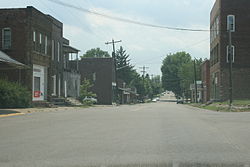Albany, Ohio
| Albany, Ohio | |
|---|---|
| Village | |

A view of Albany with State Route 681 in the background
|
|
 Location of Albany, Ohio |
|
 Location of Albany in Athens County |
|
| Coordinates: 39°13′44″N 82°12′1″W / 39.22889°N 82.20028°WCoordinates: 39°13′44″N 82°12′1″W / 39.22889°N 82.20028°W | |
| Country | United States |
| State | Ohio |
| County | Athens |
| Area | |
| • Total | 1.27 sq mi (3.29 km2) |
| • Land | 1.25 sq mi (3.24 km2) |
| • Water | 0.02 sq mi (0.05 km2) |
| Elevation | 758 ft (231 m) |
| Population (2010) | |
| • Total | 828 |
| • Estimate (2012) | 865 |
| • Density | 662.4/sq mi (255.8/km2) |
| Time zone | Eastern (EST) (UTC-5) |
| • Summer (DST) | EDT (UTC-4) |
| ZIP code | 45710 |
| Area code(s) | 740 |
| FIPS code | 39-01042 |
| GNIS feature ID | 1060817 |
Albany is a village in Athens County, Ohio, United States. The population was 828 at the 2010 census.
Albany is located at 39°13′44″N 82°12′1″W / 39.22889°N 82.20028°W (39.228787, -82.200363).
According to the United States Census Bureau, the village has a total area of 1.27 square miles (3.29 km2), of which 1.25 square miles (3.24 km2) is land and 0.02 square miles (0.05 km2) is water.
Albany was laid out in about 1832. It was incorporated as a village in 1842.
The small rural village became one of several stops in Athens County for the Underground Railroad, as fugitives could come upriver on the Hocking River from the Ohio River. Free blacks, many of whom had migrated from the Upper South, also settled the village in the mid-19th century.
The black population increased during the 1850s from four in the township to 174 by 1860. In 1860, 70 members of the black community were from the South, 53 from Virginia and 17 from other slave states.
Although Ohio laws made attending public schools difficult for African American children, private schools in Albany offered educational opportunities unavailable in most parts of the state.
In 1848, William S. Lewis founded the Lewis Academy, which admitted students regardless of race or gender. Lewis's admission policies were influenced by the liberal ideals of Oberlin College, which he had attended as a student.
In 1850, a joint-stock company took over administration of Lewis Academy and the name was changed to the Albany Manual Labor Academy. The school continued to admit students of all genders and races, and slaveholders were not permitted to become shareholders. Students with financial need could borrow money from the institution and repay their tuition by working two hours a day in the manual labor department: farming land owned by the school, operating the school's saw-mill, or making bricks.
...
Wikipedia
